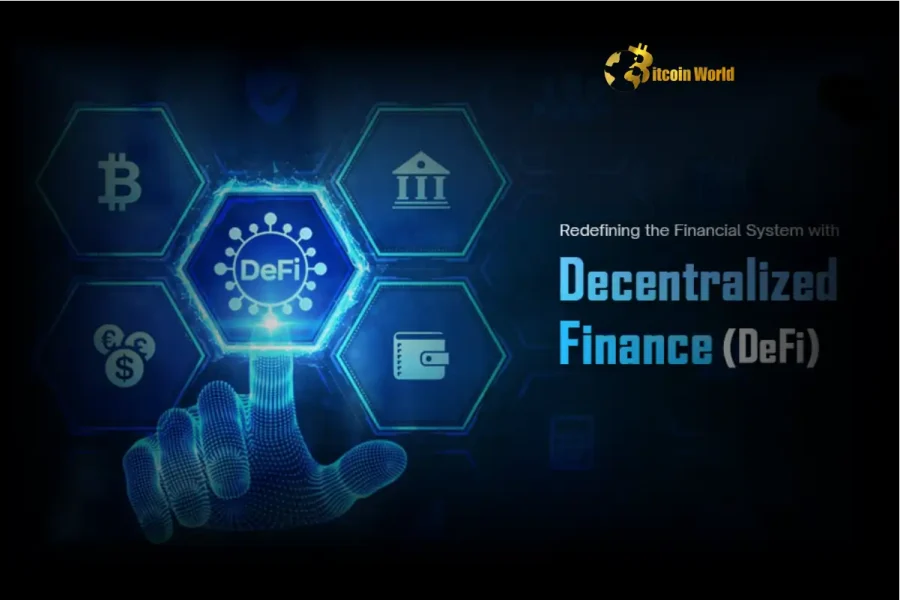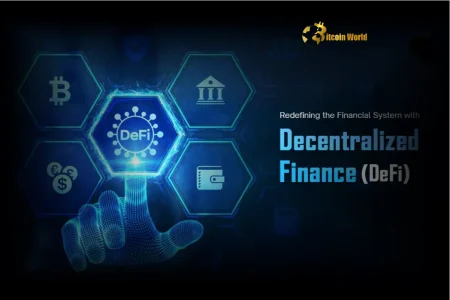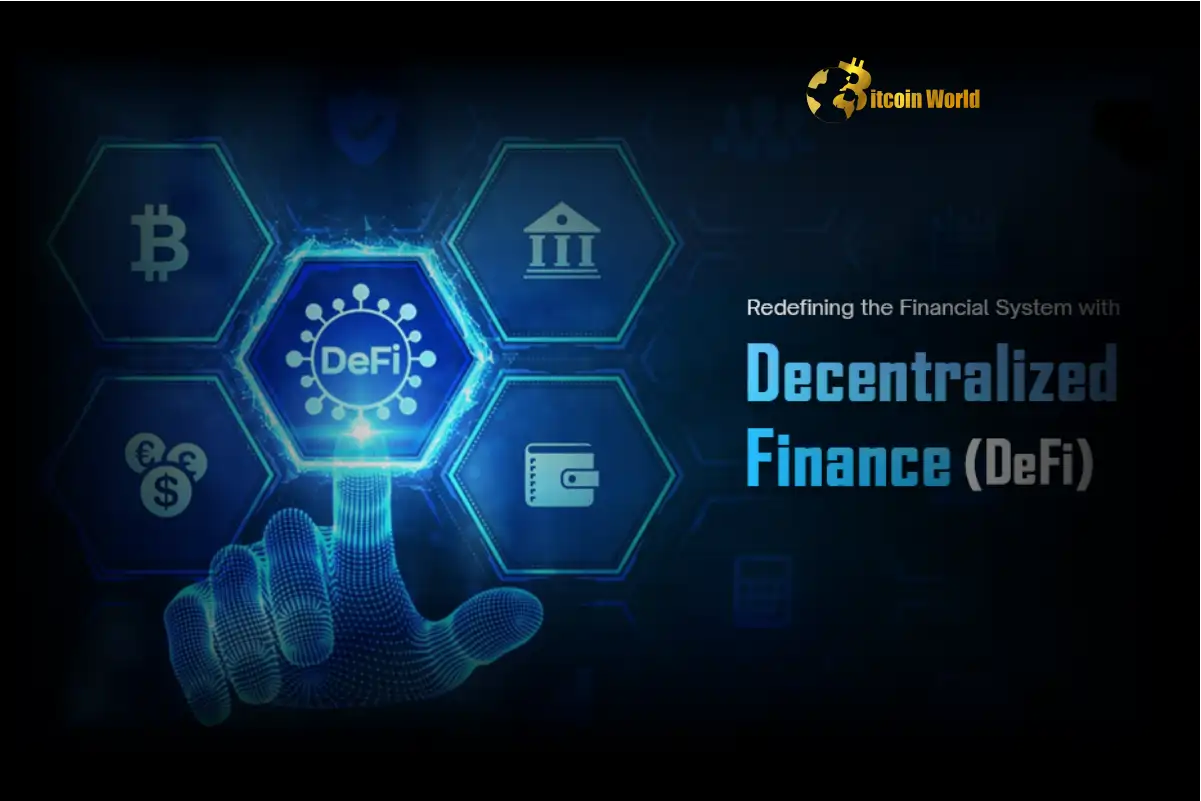DeFi: 5 Ways Decentralized Finance Will Revolutionize Money
0
0


BitcoinWorld

DeFi: 5 Ways Decentralized Finance Will Revolutionize Money
Have you heard the buzz around Decentralized Finance (DeFi)? It’s more than just a trend; it’s a movement fundamentally changing how we think about money and financial services. Imagine a world where anyone, anywhere, can access banking, loans, and investments without needing traditional intermediaries. That’s the promise of Decentralized Finance.
This isn’t just theoretical. The DeFi ecosystem is growing at an incredible pace, building a parallel financial system on blockchain technology. But what exactly is DeFi, how does it work, and why should you pay attention? Let’s dive in.
What Exactly is Decentralized Finance (DeFi)?
At its core, Decentralized Finance (DeFi) refers to a system of financial applications built on blockchain networks, primarily Ethereum. Unlike traditional finance (TradFi), which relies on centralized institutions like banks and brokers, DeFi operates on decentralized, transparent, and permissionless protocols. Think of it as finance powered by code, not corporations.
Key characteristics of DeFi include:
- Decentralization: No single entity controls the network or protocols. Decisions are often made collectively by token holders.
- Transparency: Transactions are recorded on a public blockchain, making them verifiable (though not always tied to real-world identities).
- Permissionless: Anyone with an internet connection can access DeFi services without needing approval.
- Interoperability: Different DeFi protocols can often interact and build upon each other, creating complex financial products.
- Programmability: Financial agreements are automated using smart contracts, which execute automatically when conditions are met.
This shift towards decentralized systems is opening up new possibilities for financial inclusion and innovation globally.
Exploring Key DeFi Protocols and Their Functions
The DeFi landscape is diverse, featuring various protocols offering different financial services. Understanding these DeFi protocols is crucial to navigating the ecosystem.
Some of the most prominent categories include:
- Decentralized Exchanges (DEXs): Platforms like Uniswap and SushiSwap allow users to trade cryptocurrencies directly with each other without a central authority holding funds. They often use automated market makers (AMMs) instead of traditional order books.
- Lending and Borrowing Protocols: Protocols like Aave and Compound enable users to earn interest on their crypto holdings by lending them out or borrow crypto by collateralizing their assets. This is a core function of crypto lending in DeFi.
- Stablecoins: Cryptocurrencies pegged to the value of a stable asset like the US dollar (e.g., DAI, USDC). They provide stability within the volatile crypto market and are essential building blocks for many DeFi applications.
- Yield Farming and Liquidity Mining: Strategies where users deposit crypto into protocols to earn rewards, often in the form of governance tokens. This incentivizes participation and provides liquidity to the ecosystem.
- Derivatives and Synthetic Assets: Protocols allowing users to trade tokenized versions of real-world assets or create complex financial instruments.
These DeFi protocols work together, creating a complex web of financial interactions that mimic and often innovate upon traditional financial services.
What are the Benefits of Decentralized Finance?
The appeal of Decentralized Finance stems from several compelling advantages over traditional systems:
Increased Accessibility and Financial Inclusion:
- Anyone with an internet connection and a crypto wallet can access DeFi services, regardless of location, income, or credit history. This is particularly impactful for the billions of unbanked or underbanked individuals worldwide.
- Minimum investment amounts are often much lower than in traditional finance.
Greater Transparency and Security:
- Transactions are recorded on public blockchains, offering unprecedented transparency compared to opaque traditional systems.
- Security relies on cryptographic principles and smart contract audits, rather than trusting centralized institutions.
Lower Costs and Faster Transactions:
- Automated smart contracts and reduced intermediaries can lead to lower fees compared to banks and brokers.
- Transactions often settle much faster, especially across borders.
User Control and Ownership:
- Users retain control of their private keys and assets, rather than entrusting them to a third party. This embodies the core crypto principle of ‘not your keys, not your crypto’.
Innovation and Composability:
- DeFi protocols are open-source and built on shared infrastructure, allowing developers to combine different protocols (like LEGO bricks) to create new and innovative financial products and strategies.
Navigating the Challenges and Risks in DeFi
Despite its potential, the Decentralized Finance space is not without its risks and challenges. It’s crucial to be aware of these before participating.
Common risks include:
- Smart Contract Risk: Bugs or vulnerabilities in the underlying smart contracts can lead to loss of funds. While audits help, they are not foolproof.
- Regulatory Uncertainty: The regulatory landscape for DeFi is still evolving globally, which could impact the future of certain protocols or activities.
- Volatility: Many assets used within DeFi, particularly cryptocurrencies, are highly volatile, which can impact the value of collateral or investments.
- Impermanent Loss: A risk faced by liquidity providers on DEXs, where the price change of deposited assets leads to a loss compared to simply holding the assets.
- User Error: As users are responsible for managing their own keys and transactions, mistakes like sending funds to the wrong address can result in permanent loss.
- Phishing and Scams: The open nature of DeFi makes it a target for malicious actors attempting to trick users into revealing private information or sending funds.
Engaging with DeFi protocols requires a higher degree of technical understanding and personal responsibility than traditional finance. Due diligence and understanding the specific risks of each protocol are paramount.
Examples of Decentralized Finance in Action
To make Decentralized Finance more concrete, let’s look at a couple of examples:
Example 1: Crypto Lending and Borrowing
Imagine you hold Ether (ETH) but don’t want to sell it. You can deposit your ETH into a lending protocol like Aave. Other users who need ETH can borrow it by providing different collateral (e.g., DAI or USDC). You earn interest on the ETH you lent out, paid by the borrowers. The entire process is governed by smart contracts, automatically managing collateral requirements and interest rates based on supply and demand. This exemplifies permissionless crypto lending.
Example 2: Trading on a DEX
Suppose you want to trade your ETH for DAI. Instead of using a centralized exchange like Coinbase, you can go to a DEX like Uniswap. You connect your wallet, select the trading pair (ETH/DAI), and execute the swap. Uniswap uses liquidity pools (funded by other users earning fees) and an automated market maker algorithm to facilitate the trade instantly, without needing a buyer and seller to be matched directly via an order book.
These examples highlight how DeFi removes intermediaries, automates processes via smart contracts, and allows users greater control over their assets and financial activities.
Actionable Insights for Exploring DeFi
Ready to dip your toes into Decentralized Finance? Here are some actionable steps and tips:
- Start Small: Don’t invest more than you can afford to lose. The DeFi space is experimental and carries significant risk.
- Do Your Research: Understand the specific protocol you plan to use. Read documentation, check audits, and understand how it works.
- Use Reputable Wallets: Secure your crypto with a non-custodial wallet where you control your private keys (e.g., MetaMask, Ledger).
- Understand Fees: Be aware of network transaction fees (gas fees on Ethereum can be high) and protocol fees.
- Be Wary of High APYs: Exceptionally high advertised returns (APYs) often come with correspondingly high risks. Understand the source of the yield.
- Stay Informed: Follow reputable news sources, communities, and developers in the DeFi space. The technology is constantly evolving.
- Security First: Never share your private key or seed phrase. Be cautious of phishing attempts and malicious websites. Double-check transaction details before confirming.
Exploring DeFi protocols can be rewarding, but it requires careful planning and a commitment to continuous learning and risk management.
The Future of Decentralized Finance: What’s Next?
The trajectory of Decentralized Finance looks promising, though not without potential hurdles. We’re likely to see continued innovation in existing areas like crypto lending and DEXs, alongside the development of new applications.
Potential future developments include:
- Improved Scalability: Layer 2 solutions and alternative blockchains aim to reduce transaction costs and increase speed, making DeFi more accessible.
- Increased Institutional Adoption: As regulatory clarity improves and infrastructure matures, more traditional financial institutions may explore integrating DeFi components.
- Real-World Assets (RWAs): Bringing tokenized versions of real-world assets (like real estate or stocks) onto the blockchain could expand DeFi’s scope significantly.
- Enhanced User Experience: Efforts are underway to make DeFi interfaces more user-friendly and less intimidating for mainstream users.
- Greater Interoperability: Connecting DeFi across different blockchains could unlock new possibilities.
While challenges like regulation and security persist, the momentum behind Decentralized Finance suggests it will continue to play a significant role in shaping the future of finance.
Summary: Embracing the DeFi Revolution
Decentralized Finance represents a powerful paradigm shift, leveraging blockchain technology to create open, permissionless, and transparent financial systems. From innovative DeFi protocols enabling crypto lending and trading on DEX platforms, DeFi offers significant benefits in terms of accessibility, cost, and user control.
However, it’s a nascent and rapidly evolving space with inherent risks, including smart contract vulnerabilities and regulatory uncertainty. Engaging with DeFi requires diligence, a focus on security, and a willingness to learn. As the technology matures and challenges are addressed, Decentralized Finance has the potential to fundamentally reshape global financial services, offering exciting opportunities for those willing to navigate its complexities.
To learn more about the latest Decentralized Finance trends, explore our article on key developments shaping DeFi institutional adoption.
This post DeFi: 5 Ways Decentralized Finance Will Revolutionize Money first appeared on BitcoinWorld and is written by Editorial Team
0
0
 Manage all your crypto, NFT and DeFi from one place
Manage all your crypto, NFT and DeFi from one placeSecurely connect the portfolio you’re using to start.






